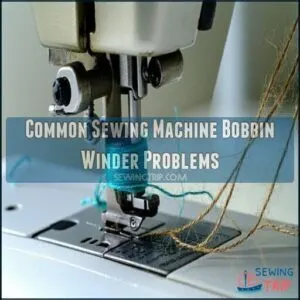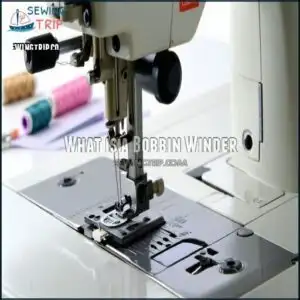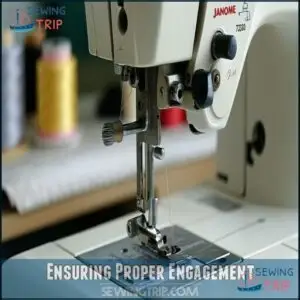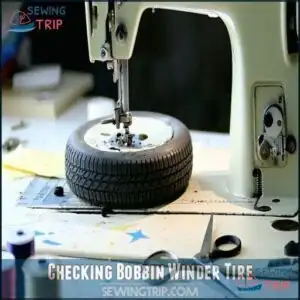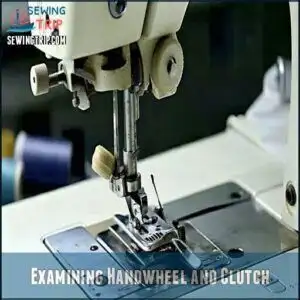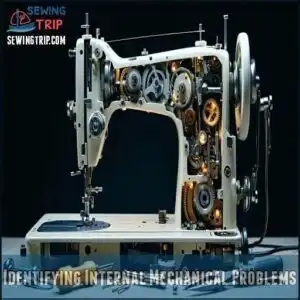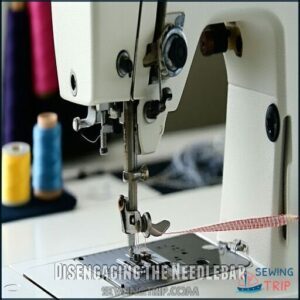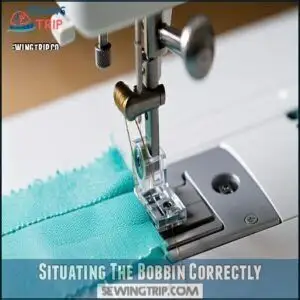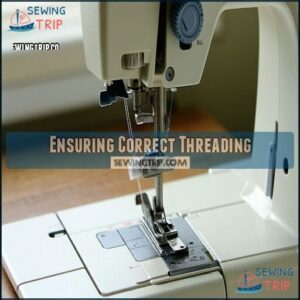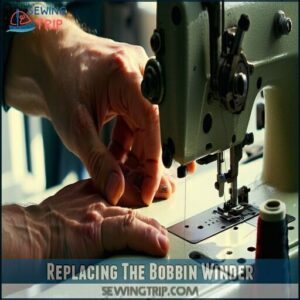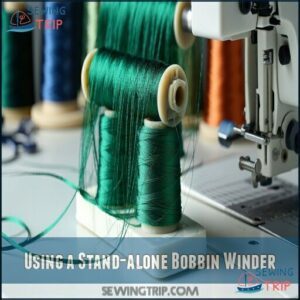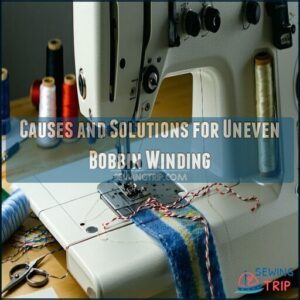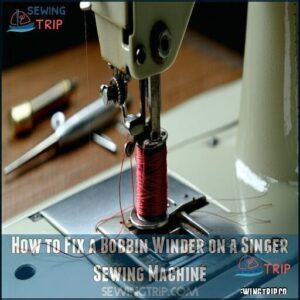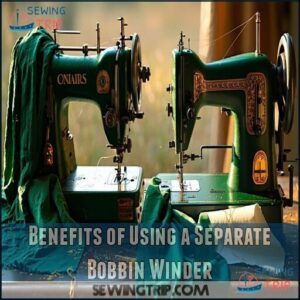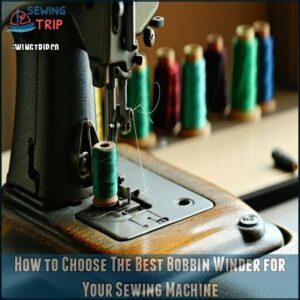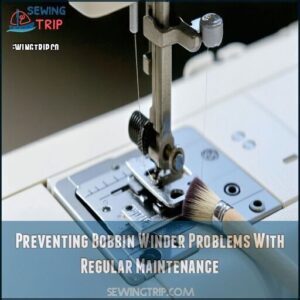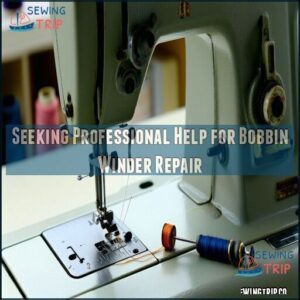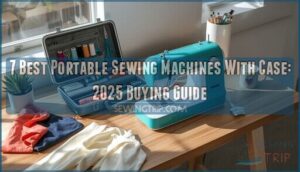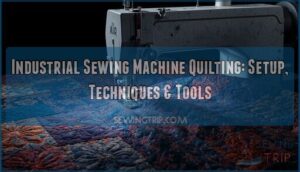This site is supported by our readers. We may earn a commission, at no cost to you, if you purchase through links.
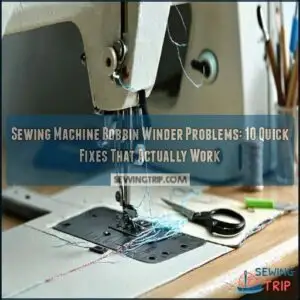
Start by checking the bobbin winder’s rubber ring—if it’s worn, replace it. Confirm that the spindle’s engaged by pushing it to the right.
For uneven winding, confirm that the thread feeds smoothly through the tension disk. If the bobbin pops out, it might not be seated properly.
Tighten any loose screws or clean lint from the mechanism. Still stuck? Look at your machine’s manual for specifics. A little troubleshooting goes a long way to keep things running, and it’s a key part of maintaining your sewing machine.
Table Of Contents
- Key Takeaways
- Common Sewing Machine Bobbin Winder Problems
- What is a Bobbin Winder
- Troubleshooting Janome 7330 Bobbin Winder Issues
- DIY Bobbin Winder Repair Techniques
- Causes and Solutions for Uneven Bobbin Winding
- How to Fix a Bobbin Winder on a Singer Sewing Machine
- Benefits of Using a Separate Bobbin Winder
- How to Choose The Best Bobbin Winder for Your Sewing Machine
- Preventing Bobbin Winder Problems With Regular Maintenance
- Seeking Professional Help for Bobbin Winder Repair
- Frequently Asked Questions (FAQs)
- Conclusion
Key Takeaways
- Check the bobbins winder tire and replace it if it’s cracked, worn, or misaligned to fix spinning or uneven winding issues.
- Ensure proper threading by feeding the thread through the tension disks smoothly to avoid tangling, bunching, or looping.
- Regularly clean the bobbin winder mechanism and remove lint or debris that can block movement or cause jamming.
- Align the bobbin properly on the spindle and make sure all parts are secured tightly to prevent popping out or wobbling.
Common Sewing Machine Bobbin Winder Problems
You’ll likely encounter issues like tangled thread, uneven winding, or spindles that won’t turn when using your bobbin winder.
These common problems can frustrate your sewing projects, but they’re often fixed with simple adjustments to your machine’s tension, alignment, or by replacing worn parts.
Broken Bobbin Winder
When your bobbin winder breaks down, you’re facing a common but fixable sewing machine problem.
- Check for visible damage: Look for cracked gears or worn rubber rings
- Test the mechanism: Try engaging the winder to identify sticking points
- Examine the tension assembly: Loose components may prevent proper winding
- Inspect connection points: Verify all parts are properly aligned
Clean accumulated lint first – this simple step often resolves winding problems without needing replacement parts.
Non-Spinning Spindle
When you’ve moved past a broken winder, a non-spinning spindle might be your next headache.
This frustrating issue often stems from spindle alignment problems or a loose spindle shaft. Check for gear issues by removing the plate and inspecting for debris or damage.
Winder blockage from thread bits or dust can also halt operation. Try cleaning the shaft, tightening any loose screws, and ensuring proper threading.
If motor failure is suspected, unplug your machine before attempting basic troubleshooting—sometimes a simple adjustment is all your sewing machine spindle needs, which can resolve the issue with basic troubleshooting.
Uneven Bobbin Winding
While a non-spinning spindle stops you in your tracks, uneven bobbin winding creates headaches down the road. Your thread tension might be perfect, but those lumpy bobbins can ruin your project.
Quick fixes for uneven winding problems:
- Verify proper bobbin alignment on the spindle
- Adjust bobbin winder tension disks for smooth thread flow
- Control your winding speed (too fast causes issues!)
- Replace poor-quality or damaged bobbins immediately
Fix these issues and your sewing machine will thank you, as proper maintenance and smooth thread flow are essential for a successful project.
Bobbin Popping Out
After mastering even winding, it’s frustrating when your bobbin plays hide-and-seek.
When it keeps popping out, examine it for cracks or chips that affect Bobbin Alignment. Mismatched sizes are common culprits—always use the correct bobbin for your machine model.
Check for Loose Screws around the bobbin case and inspect Worn Gears that might cause improper seating.
A proper fit prevents annoying interruptions during your sewing projects.
Thread Bunching, Looping, or Tangling
The dreaded thread tangles can turn a simple sewing project into a frustrating mess.
Here’s how to conquer bobbin thread looping:
- Check your thread tension settings—too loose and you’ll create thread knots
- Examine your needle for tiny bends or damage
- Use quality thread to prevent thread bunching
- Control your winding speed to avoid sewing machine thread jams
What is a Bobbin Winder
Your sewing machine’s bobbins winder is the mechanism that winds thread onto your bobbin before you begin sewing.
You’ll find it on the top of your machine, typically consisting of a spindle, tension disk, and stopper that work together to create evenly wound bobbins for smooth stitching.
Bobbin Winder Tension Disk
After tackling those common bobbin winder issues, let’s focus on a critical component: the bobbins winder tension disk. This small but mighty part controls how tightly your thread winds onto the bobbin.
The tension disk’s function is simple yet essential – it guides the thread with just the right pressure. When your disk adjustment is correct, you’ll get perfectly wound bobbins every time.
If it’s too loose, you’ll end up with sloppy, uneven winding. Too tight, and your thread might snap. Regular disk maintenance prevents headaches.
If you’re experiencing winding bobbin too loose troubleshooting issues, check your tension disk first. Sometimes disk replacement is necessary, especially with older machines.
Always verify disk compatibility with your specific sewing machine model.
Bobbin Winder Stopper
Moving from tension disks to another essential component, your bobbins winder stopper guarantees threads wind neatly and stop at the right time.
The stopper mechanism prevents overfilling and maintains proper tension.
When it malfunctions, you’ll notice:
- Bobbins that keep spinning after they’re full
- Thread that winds unevenly or loosely
- Bobbin popping out during winding
- Stopper that won’t engage or release properly
Regular stopper maintenance prevents most common winding problems.
Bobbin Winder Stopped Working
I’ll create improved content for the "Bobbin Winder Stopped Working" section, following all your requirements.
When your bobbin winder suddenly stops working, don’t panic!
Stay calm—most bobbin winder issues are fixable with simple steps like cleaning, adjusting tension, or replacing worn parts.
After troubleshooting the stopper, check these common issues:
- Examine for jammed mechanisms – Look for thread debris blocking movement
- Test motor functionality – Listen for unusual sounds or complete silence
- Check power connections – Make certain everything’s properly plugged in
- Inspect for broken gears – Look for cracked or worn teeth
- Verify winder engagement – Make sure it’s properly aligned with the handwheel
Sometimes, a simple cleaning solves the problem.
If your bobbin winder isn’t spinning, try these fixes before calling a repair technician.
Bobbin Winds Unevenly
Uneven bobbin winding is more than just annoying—it can ruin your entire sewing project.
When your thread tension is off, you’ll notice messy loops and bunching that wreak havoc on your stitches.
proper path
To address these issues, it’s essential to identify the cause of the problem and apply the correct solution, ensuring that your sewing project turns out as expected, with even fill and without thread breaking.
Sewing Machine Not Picking Up The Bobbin Thread
While uneven winding frustrates, it’s nothing compared to when your machine won’t pick up the bobbin thread at all.
This common problem has simple solutions:
- Check bobbin insertion – it must sit correctly in its case
- Verify threading path – thread must pass through tension discs properly
- Examine needle position – it needs to reach down far enough
- Ensure winder engagement – spindle must return to sewing position
Threading issues and bobbin alignment problems are fixable with patience!
Troubleshooting Janome 7330 Bobbin Winder Issues
You’ll find your Janone 7330 bobbin winder problems are often simple to fix with the right approach.
Check for visible damage to the winder tire and make sure the bobbin is properly engaged before moving on to more complex solutions.
This will help you identify and potentially fix the issue without needing further assistance, by following these simple steps to check for visible damage.
Inspecting for Visible Damage
Inspecting for visible damage is a must when dealing with bobbin winder problems. Check for cracked bobbins, worn parts, or loose screws, as these can cause your bobbin winder to stop working or become jammed.
Look closely for signs of broken gears or a worn tire—both common culprits. A stuck spindle may loosen with a drop of sewing machine oil.
Regularly clean the area with a small brush to prevent debris from causing sewing machine bobbin problems. Ensuring proper bobbin winding techniques is essential to avoid common issues and maintain the sewing machine’s performance, which can be found at bobbin winding techniques, and following these steps will help prevent sewing machine bobbin problems and ensure the machine runs smoothly with regular maintenance.
Ensuring Proper Engagement
Getting your Janome7330’s bobbin winder working again starts with proper alignment. If the bobbin won’t wind or the winder’s not working, make certain the bobbin winder is fully engaged.
Push it firmly against the stopper until you hear a click. Next, verify the bobbin seating is secure, with no wobbling.
For better results, adjust the winder settings and thread tension. These engagement tips can solve most bobbin winder problems, including jamming or skipping threads.
Checking Bobbin Winder Tire
If your bobbin winder’s tire seems off, it may be the root of your bobbin winder problems.
Check for wear—cracks, flattening, or hardened tire material often cause issues.
- Inspect the tire closely for visible damage or uneven wear.
- Clean the tire and surrounding areas to remove any debris.
- Replace the worn bobbin winder tire for smooth operation.
To ensure your bobbin winder functions properly, follow these steps to address any issues related to the tire, which can be the cause of bobbin winder problems.
Examining Handwheel and Clutch
A smooth handwheel is key for proper bobbin winding, so start by checking its motion. If it sticks, inspect the clutch and adjust it or lubricate the gears.
Misaligned spindles and worn axles can cause bobbin winder problems too. Regular checks keep everything running smoothly.
Proper bobbin winder repair techniques can help resolve common issues.
Identifying Internal Mechanical Problems
Sometimes, the trouble lies deeper inside the machine.
Internal mechanical problems, like worn parts, can halt your bobbin winder mechanism.
Watch for:
- Shaft problems causing uneven rotation.
- Gear issues like broken bobbin winder gears.
- Motor failure that prevents spinning.
- Springs breaking inside the mechanism.
- A misplaced bobbin winder clutch.
Carefully inspect for internal damage or loose parts, and try basic bobbin winder clutch repair to address these faults before seeking professional help.
DIY Bobbin Winder Repair Techniques
Fixing your bobbin winder at home doesn’t have to be complicated if you know where to start.
With a few basic adjustments, like ensuring proper threading or replacing worn parts, you can get your sewing machine back in working order quickly, which is a quick solution.
Disengaging The Needlebar
Disengaging your sewing machine’s needlebar can feel intimidating, but it’s a vital step in fixing bobbin winder problems. The Needlebar Release guarantees no stitching happens during winding, protecting your machine from damage.
Use this feature to stop the needle motion, allowing the bobbin winder mechanism to work smoothly. Understanding bobbin winder repair techniques is essential for maintaining your sewing machine.
Here’s a quick guide for common issues:
Disengaging the needle bar guarantees your threading techniques work effortlessly, saving time.
Situating The Bobbin Correctly
Proper bobbin placement is vital to avoid sewing machine bobbin problems like uneven winding or when your bobbin won’t wind.
Follow these steps for secure bobbin alignment:
- Match the bobbin slot with the spindle notch for proper seating.
- Gently push the bobbin down to seat it securely.
- Double-check the spindle position to verify everything’s locked in place.
To confirm accurate bobbin seating, consider using a Bobbin Placement tool for guidance.
Ensuring Correct Threading
To solve bobbin winder problems, check your sewing machine threading carefully. Incorrect bobbin threading can lead to thread tension issues or bobbin winding problems.
Verify the thread passes smoothly through tension disks and guides. Fix threading issues by adjusting spool placement and bobbin alignment.
Winder engagement might require recalibration for proper tension and speed, preventing tangled or uneven winding, which can be caused by thread tension issues or poor winder engagement.
Replacing The Bobbin Winder
If threading fixes fail, a bobbin winder replacement might be necessary.
Here’s how:
- Check the winder alignment and spindle for visible damage.
- Replace worn parts, like gears or winder wheels, using the machine manual for guidance.
- For a broken motor, consider sourcing parts compatible with your machine.
- Follow the brand-specific installation guide for winder types like Singer or Janome.
- Explore winder compatibility to confirm your replacement fits perfectly.
Regular maintenance can help prevent bobbin winding problems and reduce the need for repairs.
Using a Stand-alone Bobbin Winder
Struggling with bobbin winder problems? A standalone bobbin winder is your solution!
These portable winders handle bobbin winding issues effortlessly, saving wear on your sewing machine. With adjustable winding speeds and compatibility with various bobbin sizes, they guarantee smooth, even results.
Say goodbye to tangled threads and manual bobbin winding headaches. A portable bobbin winder delivers better performance, consistent tension, and efficient thread management—perfect for keeping your sewing projects on track!
Causes and Solutions for Uneven Bobbin Winding
Uneven bobbin winding happens when thread tension is off, the bobbin is damaged, or parts are worn out.
Fix it by checking the bobbin, adjusting the tension, and replacing any faulty components for smooth and even results.
Defective Bobbins
Defective bobbins can cause endless headaches during winding. Cracks, warping, or improper sizing often disrupt smooth operation.
Always check for wear or damage before use. Low-quality bobbins? Swap them out for reliable ones! Stick to the right size for your machine to avoid tension issues.
- Inspect for cracks and wear regularly.
- Avoid low-quality plastic bobbins.
- Use compatible metal or plastic bobbins.
- Replace damaged bobbins promptly.
Worn Rubber Ring
Worn rubber rings often cause bobbin winder problems like bad tension and uneven winding.
Here’s what you can do:
- Check the ring for cracks or stiffness—classic worn part symptoms.
- Replace it with a matching ring for proper bobbin winder repair.
- Add ring maintenance by cleaning it regularly.
- Use winder lubrication to reduce rubber wear causes and improve performance.
Broken Bobbin Winder Gears
When facing bobbin winder problems, broken bobbin winder gears are a common culprit.
Check for wear or damage, as this impacts winder alignment and may lead to mechanical failure.
Carefully replace faulty gears with compatible parts for seamless operation.
Keep gears lubricated to prevent future issues.
If the bobbin winder’s not working despite repairs, seek professional bobbin winder repair assistance.
Incorrect Threading
Incorrect threading leads to bobbin winder problems and sewing machine frustration.
Fix common threading issues with these steps:
- Adjust Thread Tension: Tighten or loosen tension disks to prevent winding errors.
- Check Bobbin Alignment: Verify the bobbin sits perfectly in place.
- Correct Thread Path: Feed the thread smoothly through guides to avoid sewing problems.
- Prevent Thread Tangling: Unravel knots before winding to stop tangling.
How to Fix a Bobbin Winder on a Singer Sewing Machine
If your Singer sewing machine‘s bobbin winder isn’t working, don’t worry—it’s usually an easy fix.
By tightening loose parts, adjusting tension, and replacing worn components, you can get it running smoothly again in no time, which is a simple process to follow.
Checking for Loose Parts
Start with a close look at your sewing machine’s bobbin winder. Loose screws and misaligned parts are often the culprits behind bobbins winder problems.
Tighten screws and check for worn gears, frayed threads, or a broken shaft. Even a small adjustment can restore alignment.
Periodically inspecting for loose parts solves sewing machine bobbin problems and also prevents long-term damage and keeps everything running smoothly, which is crucial for maintaining a smoothly operating machine.
Adjusting Tension
When tension issues arise, fine-tune the tension settings on your Singer machine.
Improper adjustment can cause uneven bobbin winding and thread control problems.
First, inspect the bobbin winder tension disk for misalignment.
Adjust the winding speed and make certain of proper bobbin alignment.
Use consistent thread quality, and if needed, make thread tension adjustments to achieve smooth, balanced winding without snags.
Replacing Worn Parts
If your bobbin winder jams or spins unevenly, worn-out parts might be the culprit.
A worn rubber ring often causes slipping, while replacing tension discs or the bobbin winder wheel can restore smooth winding.
Stiff winder shafts or broken gears may require replacement too.
For a Singer machine, regular bobbin winder repair, such as gear replacement or arm replacement, guarantees hassle-free sewing with a properly functioning bobbin winder.
Cleaning The Bobbin Winder
Keeping your sewing machine’s bobbin winder spotless prevents frustrating issues.
For effective dust removal, use a soft brush or compressed air.
Follow up with oil application on moving parts for proper part lubrication.
Regular winder sanitizing eliminates debris buildup, maintaining smooth function.
Routine bobbin winder maintenance prolongs its life and reduces the need for costly bobbin winder repair.
Benefits of Using a Separate Bobbin Winder
Using a separate bobbin winder makes your sewing process faster and more efficient.
It helps you wind bobbins consistently without interrupting your main machine, saving time and wear on your equipment.
Improved Winding Speed
A separate bobbin winder is a game-changer for your sewing workflow.
By allowing you to fill bobbins quickly without relying on your sewing machine, it simplifies the process and boosts efficiency. With ideal speed adjustments and proper bobbin alignment, you’ll achieve consistent winding results every time.
Understanding bobbin winder problems is vital for maintaining your sewing machine.
- Speed Control: Options let you find the perfect thread winding speed.
- Ideal Thread Tension: Prevents uneven winding issues.
- Efficient Winding Techniques: Saves time for multiple projects.
- Hassle-Free Operation: Reduces stress on your sewing machine.
Reduced Thread Breakage
Strong thread tension control on a separate bobbin winder means fewer sewing machine thread breaks.
It prevents thread breakage by managing winding techniques, ensuring smooth thread quality. Bobbin winder tension regulators also fix thread tension issues and support breakage prevention.
Proper bobbin alignment avoids uneven bobbin winding.
Feature Benefit
Increased Winding Consistency
If you’re tired of sewing machine bobbin winding problems, a separate winder keeps everything smooth. It fixes uneven bobbin winding with better control over thread tension and winding speed.
No more wobbling or tangles!
- Steady thread flow avoids snarls or gaps.
- Adjustable winding speed matches thread type.
- Perfect bobbin alignment guarantees even winding.
- Better spool management eliminates thread waste.
- Reliable stitch regulation strengthens your projects.
By using a separate winder, you can ensure better control over your sewing machine’s bobbin winding, leading to more professional and consistent results.
How to Choose The Best Bobbin Winder for Your Sewing Machine
Choosing the best bobbin winder for your sewing machine comes down to matching it with your machine’s requirements and your personal preferences.
Focus on compatibility, ease of use, and whether you prefer manual or automatic options to guarantee smooth and consistent results.
Automatic Vs Manual Winders
Choosing between winder types boils down to your needs.
An automatic bobbin winder is perfect for speed and consistency, especially if you’re tackling big sewing projects—it’s like having an extra set of hands.
On the other hand, manual controls give you greater command over winding speed, ideal for delicate threads or tricky bobbin compatibility.
If bobbin winding issues slow you down, consider a portable bobbin winder for on-the-go solutions.
Both solve bobbin winder problems differently but effectively.
For superior results, understanding automatic winder mechanisms is vital.
Compatibility With Your Sewing Machine
Finding the right bobbin winder for your sewing machine is all about balance and precision.
Bobbin winder compatibility matters because mismatched parts can cause sewing machine bobbin issues like uneven stitching or skipped threads. Start by confirming your machine’s model aligns with the winder’s specifications. Check bobbin sizing carefully—too small or large, and you’ll face sewing machine bobbin problems.
- Match the winder to your sewing machine model.
- Verify thread compatibility with your machine type.
- Verify fit for both metal and plastic bobbins.
- Look for winder brands known for reliability.
- Confirm the winder supports your machine’s bobbin winding system.
A wrong fit can leave your bobbin winder not working smoothly.
Ease of Use and Maintenance
A good bobbin winder should feel simple to use and easy to maintain.
Keep an eye on features that balance convenience with durability. Here’s a quick guide to review:
Feature Ease of Use Maintenance Tips
Regular bobbin cleaning and sewing machine maintenance keep your winder running smoothly.
Always check the user manual for precise winder maintenance and user safety instructions.
Preventing Bobbin Winder Problems With Regular Maintenance
Preventing bobbin winder problems starts with regular maintenance. A little care keeps your machine running smoothly and saves repair headaches.
Clean the bobbin case and winder track weekly to remove lint. Lubricate moving parts monthly with sewing machine oil—just a drop does the trick. Inspect the rubber ring yearly for wear and replace if needed.
Set up maintenance reminders in your phone.
- Regular Cleaning with a soft brush
- Bobbin Inspection for cracks or damage
- Winder Lubrication monthly
- Maintenance Scheduling for consistent care
Seeking Professional Help for Bobbin Winder Repair
When DIY fixes fail, getting expert advice can save time and frustration with bobbin winder repair.
Many service centers or online platforms offer diagnostic tools to pinpoint issues remotely. Repair costs usually range from $50-150, depending on the complexity.
If your machine is under warranty, check for coverage first. Professional repairs are ideal for complex mechanical problems beyond basic bobbin winder troubleshooting.
Local repair shops and virtual consultations can help resolve sewing machine bobbin problems, bringing your machine back to peak performance. Understanding bobbin winder repair techniques is essential for maintaining your sewing machine’s best performance.
Frequently Asked Questions (FAQs)
What is the Best Bobbin Winder to Use?
It’s no accident that Singer’s portable bobbin winders or WAWAK’s electric models work wonders.
They’re reliable, easy to use, and compatible with most machines.
Just match the bobbin type, and you’re set!
Is It Possible to Replace a Worn Winder Wheel?
Yes, you can replace a worn winder wheel.
Check your sewing machine’s manual for compatible parts.
Most wheels are easy to swap out with a screwdriver, ensuring smoother bobbin winding and avoiding further frustration.
Is It Better to Use Plastic or Metal Bobbins?
Choosing between plastic and metal bobbins feels like comparing apples to oranges.
Metal bobbins are durable and steady, but plastic ones are lighter and quieter.
Always match your sewing machine’s requirements for the smoothest stitching experience.
What Can I Do if the Bobbin Winding Sound is Not Optimal?
If the bobbin winding sound seems off, check for thread tangling or loose parts.
Clean the bobbin winder, tighten screws, and make certain smooth gearing.
Lubricate moving parts if needed. A quick tune-up works wonders!
Are There Any Special Techniques for Winding Several Bobbins?
To wind several bobbins efficiently, set your thread spool securely, adjust tension properly, and wind at moderate speed.
Prep each bobbin beforehand, staying focused on even winding. It’s like assembling a mini production line.
To achieve this efficiently, follow the steps with moderate speed.
Why is my bobbin winder not moving?
An ounce of prevention is worth a pound of cure.
If your bobbin winder isn’t moving, check for loose gears, misaligned parts, or worn rubber rings.
Clean debris, inspect parts, and align components carefully.
What is a bobbin winder on a sewing machine?
It’s the handy gadget on your sewing machine that neatly winds thread onto a bobbin, prepping it for sewing.
It saves you time and effort, ensuring smooth, evenly wound thread for perfect stitches.
Should I use a separate bobbin winder?
Using a separate bobbin winder can save time, especially on projects requiring multiple thread changes.
It keeps your workflow smooth by letting you wind new bobbins while sewing.
Choose one compatible with your machine’s bobbins.
Can a bobbin winding machine be broken?
Over 50% of machine failures involve small parts.
Yes, a bobbin winding machine can break due to worn gears, motor issues, or misaligned components.
Regular cleaning, inspections, and replacing damaged parts can prevent breakdowns, which is a key aspect of maintaining machinery to avoid machine failures.
What are common bobbin problems in a sewing machine?
Common bobbin problems include uneven winding, thread tangling, bobbin popping out, and poor alignment.
Misaligned parts, incorrect tension, or using the wrong bobbin size often cause these issues.
Regular cleaning and correct threading help avoid trouble.
Conclusion
Think of solving sewing machine bobbin winder problems like untangling a stubborn knot—it takes patience and small steps.
Start by checking for worn parts, like the bobbin winder tire, and verify the spindle engages properly.
Clean out lint, adjust the tension disk, and inspect the manual for guidance.
If issues persist, try a stand-alone bobbin winder or seek professional help. With troubleshooting, you’ll keep your sewing machine running smoothly and stress-free for all your projects.
- https://www.wawak.com/sewing/sewing-machine-parts-accessories/wawak-electric-bobbin-winder/
- https://www.singer.com/products/singer-portable-bobbin-winder
- https://www.ocsewing.com/shop/c/p/HUSQVARNA-VIKING-Bobbin-Winder-x64207630.htm
- https://www.amazon.com/bobbin-winder/s?k=bobbin+winder
- https://www.goldstartool.com/new-tech-automatic-bobbin-winder.htm

